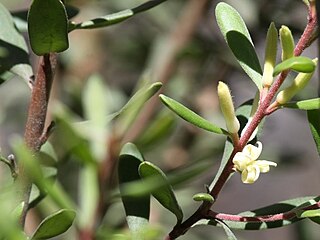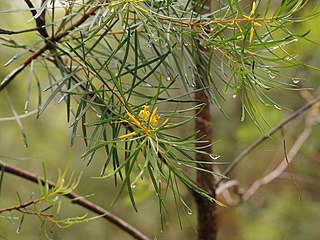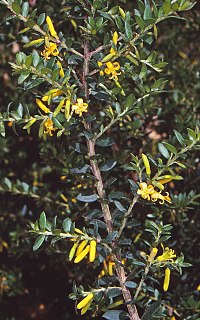
Persoonia, commonly known as geebungs or snottygobbles, is a genus of about one hundred species of flowering plants in the family Proteaceae. Plants in the genus Persoonia are shrubs or small trees usually with smooth bark, simple leaves and usually yellow flowers arranged along a raceme, each flower with a leaf or scale leaf at the base. The fruit is a drupe.
Persoonia micranthera, commonly known as the small-flowered snottygobble, is a species of flowering plant in the family Proteaceae and is endemic to a restricted area in the south-west of Western Australia. It is a low-lying to prostrate shrub with branchlets that are hairy when young, spatula-shaped to lance-shaped leaves with the narrower end towards the base, hairy yellow flowers borne in groups of four to fifteen, and smooth, oval fruit.

Persoonia rigida, commonly known as the rigid-, hairy- or stiff geebung, is a species of flowering plant in the family Proteaceae and is endemic to south-eastern Australia. It is an erect to low-lying shrub with hairy young branchlets, lance-shaped to spatula-shaped leaves that are hairy when young, and yellow flowers borne in groups of up to twenty on a rachis up to 90 mm (3.5 in) long that continues to grow after flowering.

Persoonia subvelutina, commonly known as velvety geebung, is a plant in the family Proteaceae and is endemic to south-eastern Australia. It is a spreading to small tree with branchlets that are hairy when young, elliptic, lance-shaped, egg-shaped or spatula-shaped leaves and yellow flowers arranged singly in leaf axils on a pedicel 1–4 mm (0.039–0.157 in) long.

Persoonia myrtilloides, commonly known as myrtle geebung, is a plant in the family Proteaceae and is endemic to New South Wales. It is an erect to spreading shrub with elliptic to egg-shaped leaves and yellow flowers in groups of up to forty on a rachis up to 170 mm (6.7 in) long.

Persoonia glaucescens, commonly known as the Mittagong geebung, is a species of flowering plant in the family Proteaceae and is endemic to New South Wales. It is an erect shrub with smooth bark, hairy young branchlets, lance-shaped leaves with the narrower end towards the base, and yellow flowers. It is the only persoonia in eastern Australia with strongly glaucous leaves.

Persoonia virgata is a species of flowering plant in the family Proteaceae and is endemic to coastal areas of eastern Australia. It is usually an erect shrub with smooth bark, hairy young branchlets, linear to narrow spatula-shaped leaves, and yellow flowers borne in groups of up to seventy-five on a rachis up to 230 mm (9.1 in) long that continues to grow after flowering.

Persoonia mollis, commonly known as soft geebung, is a plant in the family Proteaceae and is endemic to New South Wales. It is an erect to prostrate shrub with linear to oblong or spatula-shaped leaves, yellow flowers in groups of up to thirty on a rachis up to 150 mm (5.9 in) long and relatively small fruit.

Persoonia bargoensis, commonly known as the Bargo geebung, is a species of flowering plant in the family Proteaceae and is endemic to a restricted area of New South Wales. It is an erect shrub with linear to lance-shaped leaves, yellow, tube-shaped flowers and green, pear-shaped fruit.

Persoonia gunnii is a species of flowering plant in the family Proteaceae and is endemic to Tasmania. It is an erect shrub with young branchlets that are hairy at first, spatula-shaped to egg-shaped leaves with the narrower end towards the base, and white to cream-coloured flowers.

Persoonia asperula, commonly known as mountain geebung, is a plant in the family Proteaceae and is endemic to south-eastern Australia. It is an erect or prostrate shrub with smooth bark, mostly elliptic to oblong leaves and yellow flowers borne singly or in groups of up to nine. It mostly occurs in the Southern Highlands of New South Wales. A small population in Victoria may be a different species.

Persoonia conjuncta is a species of flowering plant in the family Lamiaceae and is endemic to eastern New South Wales. It is an erect shrub or small tree with narrow elliptic to lance-shaped leaves, yellow, tube-shaped flowers in groups of up to sixteen and green fruit.

Persoonia oleoides is a species of flowering plant in the family Proteaceae and is endemic to north-eastern New South Wales. It is an erect to low-lying shrub with oblong to egg-shaped leaves and yellow flowers in groups of up to twenty-five on a rachis up to 130 mm (5.1 in) long.

Persoonia brevirhachis is a species of flowering plant in the family Proteaceae and is endemic to the south-west of Western Australia. It is an erect, often spreading shrub with smooth, compact bark, mostly narrow spatula-shaped to lance-shaped leaves with the narrower end towards the base and yellow to greenish yellow flowers borne singly or in pairs in leaf axils.

Persoonia daphnoides is a plant in the family Proteaceae and is endemic to a restricted area near the border of eastern New South Wales and Queensland. It is a prostrate shrub with spatula-shaped to egg-shaped leaves with the narrower end towards the base, and yellow flowers in groups of up to eight on a rachis up to 35 mm (1.4 in) long.

Persoonia cuspidifera is a species of flowering plant in the family Proteaceae and is endemic to northern New South Wales. It is an erect shrub with spatula-shaped leaves and greenish yellow, tube-shaped flowers in groups of up to twenty-five.

Persoonia brevifolia is a plant in the family Proteaceae and is endemic to a restricted area near the border between south-eastern New South Wales and Victoria. It is an erect shrub with elliptic to egg-shaped leaves and cylindrical yellow flowers arranged singly in leaf axils.
Persoonia volcanica is a species of flowering plant in the family Proteaceae and is endemic to eastern Australia. It is an erect shrub with hairy young branchlets, egg-shaped to oblong leaves, and yellow flowers borne in groups of up to twenty on a rachis up to 180 mm (7.1 in) that usually continues to grow after flowering, each flower with a leaf at its base.
Persoonia brachystylis is a species of flowering plant in the family Proteaceae and is endemic to a restricted area on the west coast of Western Australia. It is an erect, spreading shrub with smooth bark, narrow spatula-shaped to lance-shaped leaves and yellow flowers in groups of ten to twenty.

Persoonia comata is a species of flowering plant in the family Proteaceae and is endemic to the south-west of Western Australia. It is an erect, sometimes spreading to low-lying shrub with mostly smooth bark, spatula-shaped to lance-shaped leaves with the narrower end towards the base and yellow flowers usually in groups of ten to fifty along a rachis up to 250 mm (9.8 in) long.




















